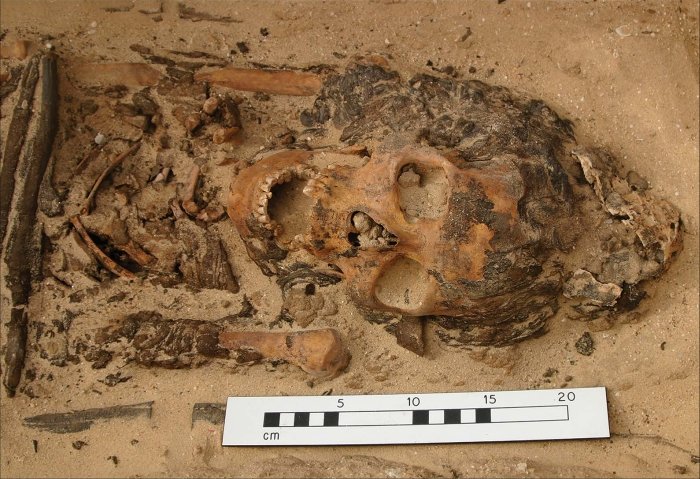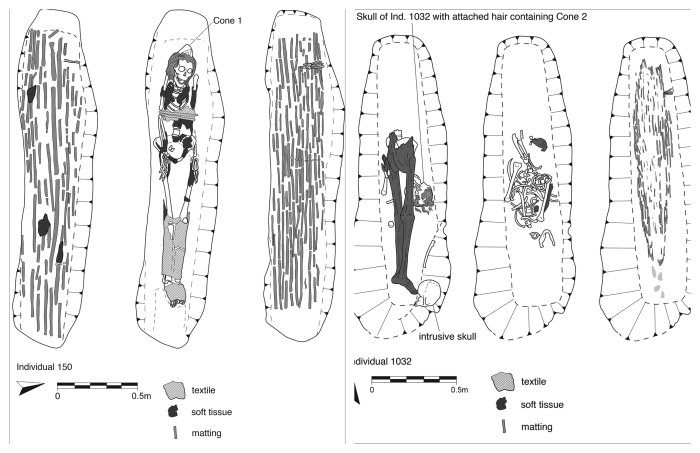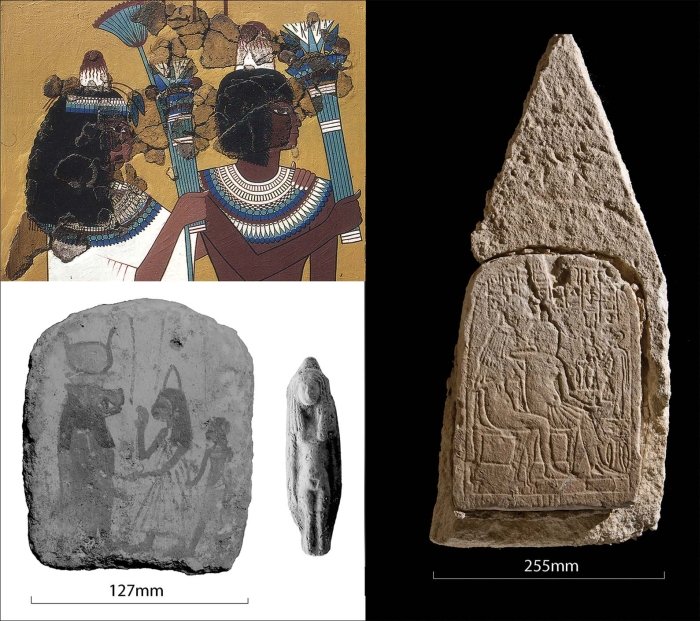原来,古埃及艺术中奇怪的头锥实际上是真正的帽子
原来,古埃及艺术中奇怪的头锥实际上是真正的帽子
Most of the garments depicted in ancient Egyptian art are relatively straightforward to decipher, but there's a particular wearable article that has baffled archaeologists. In statuary, murals, funerary stelae, coffins and relief sculptures dating between 3,570 and 2,000 years ago, people repeatedly appeared wearing cones on their heads, a bit like party hats.
古埃及艺术中描绘的大多数服装相对来说都比较简单易懂,但有一件特殊的可穿戴物品却让考古学家们大惑不解。在3570年至2000年前的雕塑、壁画、随葬石碑、棺材和浮雕中,人们反复戴着锥状头饰出现,有点像聚会时戴的帽子。
Now, for the first time, archaeologists have actually identified two such cones, crafted out of wax and adorning the heads of skeletons dating back some 3,300 years. The finds were excavated from the cemeteries of the city of Akhetaten, also known as Amarna.
现在,考古学家们第一次发现了两个这样的锥状物,它们是用蜡制作而成,装饰在3300年前的骷髅头上。这些发现是在阿赫塔吞(又名阿玛纳)的墓地中挖掘出来的。
This discovery may finally help to resolve several hypotheses over the meaning of these head cones, and what their function may have been back in the day.
这一发现可能最终有助于解决关于这些头锥的意义的几个假设,以及它们在当时的功能。

The excavation of two cones from the Amarna cemeteries confirms that three-dimensional, wax-based head cones were sometimes worn by the dead in ancient Egypt, and that access to these objects was not restricted to the upper elite, the researchers wrote in their paper.
研究人员在他们的论文中写道:“从阿玛纳墓地挖掘出的两个视锥细胞证实,在古埃及,死者有时会戴上三维的、以蜡为基础的视锥细胞,而且接触这些物体并不仅限于上层精英。”
The Amarna discovery supports the idea that head cones were also worn by the living, although it remains difficult to ascertain how often and why.
“阿玛纳的发现支持了头锥也被活着的人戴上的观点,尽管很难确定戴的频率和原因。”
Akhetaten itself is a curiosity. The city was set up by the Pharaoh Akhenaten, who famously went religiously rogue, setting up his own cult to the sun-god Aten. He established Akhetaten as his capital city in around 1346 BCE, but his attempt to steer Egypt to a new religion was not popular, and Akhetaten was abandoned not long after the Pharaoh's death in 1332 BCE.
阿玛纳本身就是一件珍品。这座城市是由阿赫那吞法老建立的,他是出了名的宗教流氓,建立了自己对太阳神阿吞的崇拜。大约在公元前1346年,他建立了阿赫塔吞作为他的首都,但是他试图将埃及引向一种新的宗教并不受欢迎,在公元前1332年法老死后不久,阿赫塔吞就被废弃了。

In art discovered in the city, as well as Egypt at large, the head cone makes a not-infrequent appearance. It's often depicted on the heads of guests at a banquet, or tomb owners participating in funerary rituals or being rewarded by a king.
在这座城市以及整个埃及发现的艺术品中,头锥的出现并不罕见。它通常被描绘在参加宴会的客人的头上,或参加葬礼仪式的坟墓主人或被国王奖励。
The two skeletons found wearing the cones at Akhetaten belonged to a woman around 29 years of age, and an individual whose sex has not been determined, aged between 15 and 20 years.
在阿玛纳发现的两具戴着视锥细胞的骨骼,分别属于一名29岁左右的女性,以及一名年龄在15至20岁之间、性别尚未确定的女性。
The woman, excavated in 2010, was in good condition, still intact as she had been laid to rest. She still retained her hair; tangled up in it was the cone, broken apart and burrowed through by insects, but recognisable.
这名女子于2010年出土,目前状况良好,在下葬时仍然完好无损。她仍然留着她的头发;圆锥体缠在一起,被昆虫撕破、钻穿,但仍能辨认出来。

Interestingly, a pattern imprinted on the inside of the cone seemed consistent with fabric weave, as though the interior of the wax structure had been lined.
有趣的是,圆锥体内部的图案似乎与织物组织相一致,就好像蜡结构的内部是有衬里的。
The grave of the second individual, excavated in 2015, had been robbed, leaving the skeleton jumbled together at the foot of the grave. However, it too had retained hair; and in this hair, the researchers identified a second cone.
2015年挖掘出的第二个人的坟墓被抢了,剩下的骨架在坟墓脚下杂乱地堆在一起。然而,它也留着头发;研究人员在这头发上发现了第二个锥体。
Although these discoveries don't reveal the purpose of the cones, they do narrow things down a bit. For instance, both burials were simple and uninscribed, from a cemetery interpreted as belonging primarily to labourers.
虽然这些发现并没有揭示视锥细胞的用途,但它们确实缩小了范围。例如,这两种埋葬方式都很简单,没有铭文,人们认为这是一块主要属于劳动者的墓地。
This could mean that, either the head cones were not just for high-status members of society but for everyone; or, as also inferred from a recently discovered burial, that the workers copied what they saw the nobility doing.
这可能意味着,头锥不仅是为社会地位高的成员,而是为每个人;或者,从最近发现的一处墓葬推断,工人们模仿了他们看到的贵族的行为。
- 频道推荐
- |
- 全站推荐
- 推荐下载
- 网站推荐


















